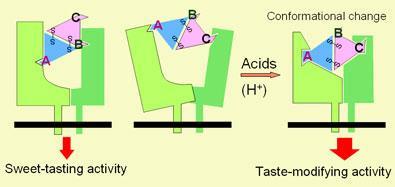Scientists have shown how the protein curculin can turn sour tastes sweet
Japanese scientists have shown for the first time how the protein curculin performs its unique trick of turning sour tastes sweet.
A team led by Koichi Kato of Nagoya City University has discovered that curculin, found naturally in fruit of the tropical plant Curculigo latifolia, normally fits the taste receptors on the tongue in a way that makes it taste sweet. But when exposed to acidic conditions - a hallmark of sour tastes- curculin’s structure flips so it blocks the taste receptor and stops it detecting the sour taste.
The researchers used X-ray crystallography to look at the structures of curculin, which normally exist as pairs. They found that the protein molecules bind to each other in one of two different ways depending on pH.

’These findings may provide new insights into the molecular mechanisms for activation of taste receptors and . [help to] design a novel low-calorie sweetener with improved sweet-tasting and taste-modifying activities,’ Kato told Chemistry World.
There have been suggestions that some low-calorie sweeteners - such as aspartame- may carry health risksso soft drinks makers are on the look out for alternatives.
Richard Laming, a spokesman for the British Soft Drinks Association, said, ’There are 200 soft drink innovations each year and consumers are always looking for new tastes. One part of making a new recipe is choosing the correct sweetener profile, so any new sweetener will potentially present new options for drinks recipes.’
Jonathan Edwards
References
Kurimoto






No comments yet